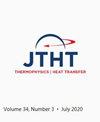Effects of Hydrogen/Methane on the Thermal Environment of Heavy-Duty Gas Turbine Combustor
IF 1.7
4区 工程技术
Q4 ENGINEERING, MECHANICAL
引用次数: 0
Abstract
Hydrogen is the most promising fuel for reducing carbon emissions, but hydrogen combustion produces higher temperature compared to hydrocarbon fuel. In this paper, a three-dimensional compressible combustion–flow–heat transfer model of combustor was established, and a dry-low-emission combustor was examined by using the realizable [Formula: see text] model, transported probability density function, and discrete ordinates model combining weighted sum of gray gas model, analyzing the effects of hydrogen/methane blended fuel and thermal boundaries on the combustor thermal environment. The results show that when the fuel hydrogen volume percentage increases from 0 to 75%, the maximum gas temperature and [Formula: see text] concentration on the central axis of the combustor increase by about 160.8 and 662.9%, respectively; the maximum incident radiant heat flux of the combustor wall increases by about 150%; and the local maximum ratio of the radiant heat transfer to the total heat transfer through the wall increases from about 34 to about 49%. The effect of the boundary conditions varies depending on the hydrogen percentage. At the hydrogen percentage of 75%, the maximum wall-incident radiant heat flux under the adiabatic condition is nearly 180.3 and 77.4% higher than the values at 1370 and 1920 K isothermal boundaries, respectively.氢/甲烷对重型燃气轮机燃烧室热环境的影响
氢是最有希望减少碳排放的燃料,但与碳氢化合物燃料相比,氢燃烧产生的温度更高。本文建立了燃烧室三维可压缩燃烧-流动-传热模型,并采用可实现的[公式:见文]模型、传递概率密度函数和结合灰色气体模型加权和的离散坐标模型对干式低排放燃烧室进行了试验,分析了氢/甲烷混合燃料和热边界对燃烧室热环境的影响。结果表明:当燃料氢体积百分比从0增加到75%时,燃烧室中轴线上的最高燃气温度和[公式:见文]浓度分别提高了约160.8%和662.9%;燃烧室壁面最大入射辐射热通量增加约150%;局部最大辐射换热与壁面总换热之比由34%左右增加到49%左右。边界条件的影响随氢含量的变化而变化。当氢含量为75%时,绝热条件下的最大壁面入射辐射热流密度比1370 K和1920 K等温边界分别高出近180.3和77.4%。
本文章由计算机程序翻译,如有差异,请以英文原文为准。
求助全文
约1分钟内获得全文
求助全文
来源期刊

Journal of Thermophysics and Heat Transfer
工程技术-工程:机械
CiteScore
3.50
自引率
19.00%
发文量
95
审稿时长
3 months
期刊介绍:
This Journal is devoted to the advancement of the science and technology of thermophysics and heat transfer through the dissemination of original research papers disclosing new technical knowledge and exploratory developments and applications based on new knowledge. The Journal publishes qualified papers that deal with the properties and mechanisms involved in thermal energy transfer and storage in gases, liquids, and solids or combinations thereof. These studies include aerothermodynamics; conductive, convective, radiative, and multiphase modes of heat transfer; micro- and nano-scale heat transfer; nonintrusive diagnostics; numerical and experimental techniques; plasma excitation and flow interactions; thermal systems; and thermophysical properties. Papers that review recent research developments in any of the prior topics are also solicited.
 求助内容:
求助内容: 应助结果提醒方式:
应助结果提醒方式:


